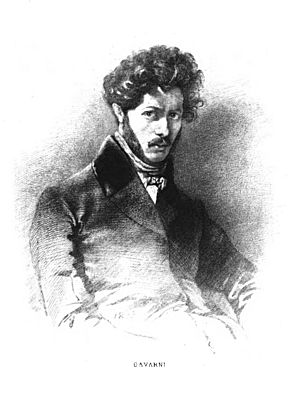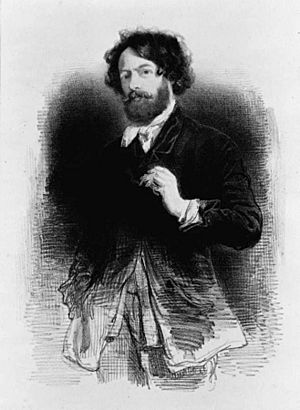Paul Gavarni facts for kids
Paul Gavarni was a famous French artist. His real name was Sulpice Guillaume Chevalier. He was born in Paris on January 13, 1804, and passed away on November 24, 1866. He became well-known for his amazing drawings and illustrations.
Contents
Becoming an Artist
Paul Gavarni's father was a cooper, which is someone who makes barrels. Paul first worked in a machine factory. He soon realized that drawing skills would help him advance in his job. So, he took drawing classes in the evenings. He focused on architectural and mechanical drawing. He even worked as a draughtsman for the government. But it wasn't until he was about 30 that he became a full-time artist.
Choosing His Pen Name
Paul Chevalier chose the name Gavarni as his pen name. People say he picked this name after a trip he took to Gavarnie. This place is in the Pyrenees mountains. His very first drawings were published in a magazine called Journal des modes.
Gavarni was around 30 years old when his drawings started getting noticed. His clever and funny drawings made everyday people look very real. This quickly made him famous in fashionable parts of society. He started focusing more on his art. Eventually, he stopped working as an engineer. He then became the director of a magazine called Les Gens du monde.
Drawing French Life
Gavarni loved to draw different parts of French society. He created many lithographed sketches. These drawings showed the unique habits and even the funny flaws of people. He often added short, witty explanations to his pictures. At first, he mainly drew about life in Paris. He especially focused on young people in the city.
Some of his famous illustrated works include Les Lorettes (about women of fashion) and Les Étudiants de Paris (about students). He also drew about masked balls and carnivals. Gavarni became the main cartoonist for a newspaper called Le Charivari. His popular drawings helped the paper become very successful. Publishers also eagerly wanted his illustrations for books.
His art helped make many books popular. These included Le Juif errant by Eugene Sue. He also illustrated the French version of Hoffman's tales. Gavarni's clever sketches were a big reason why these books sold so well.
New Artistic Focus
Gavarni always wanted to explore new ideas in his art. He soon moved on from his earlier topics. He stopped drawing only about Parisian students or city pleasures. Instead, he started looking at the funny and sometimes sad parts of family life. He explored human nature in a deeper way.
His later works included series like Les Enfants terribles (Terrible Children). He also drew Les Parents terribles (Terrible Parents). These drawings showed his strong sense of irony. They also showed a deeper understanding of people. Sometimes, his later art had a more serious or even gloomy feeling.
Travel to England
Gavarni visited England in 1849. When he returned, his thoughts about England were published. These were in a book called Londres et les Anglais, illustrés par Gavarni. Most of his later drawings appeared in a weekly paper called L'Illustration.
In 1857, he published a collection of his works called Masques et visages. Two years after he passed away, his last art project was released. It was called Les Douze Mois (The Twelve Months).
Later Interests and Legacy
In his later life, Gavarni became very interested in science. This might be why his art style changed. He sent several ideas to the French Academy of Sciences. Until his death in 1866, he was very keen on the idea of flying. He even did experiments to try and find ways to steer balloons. However, he wasn't as successful in this as another artist, Nadar, who was also a caricaturist and photographer.
Many of Gavarni's best works were collected and published. Œuvres choisies came out in 1845. Later, two volumes called Perles et Parures were published in 1850. Some of his writings were also collected and published after his death. Books about his life and art were also written, helping people remember his important contributions.
See also
 In Spanish: Paul Gavarni para niños
In Spanish: Paul Gavarni para niños





